Rolf Potts's Blog, page 99
April 19, 2012
Vagabonding as a rock musician: a step by step guide. Post #4: How to choose where to tour
Vagablogging :: Rolf Potts Vagabonding Blog
This article is the fourth in a series of posts explaining how to bring your music on the road and get to travel with it. Read the series’ introduction , Post#1 , Post # 2 and Post #3
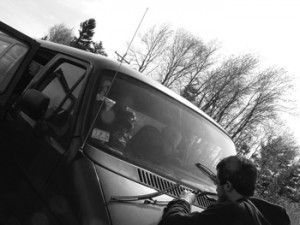
picture credit: http://performermag.com/Archives/DIY....
In the last article of this series I mentioned that a band may decide to book their own tours, by themselves, using their own forces. This is totally right and possible, but is a long, dreary process presenting more than a few risks. Exactly like planning a Round the World trip, there are many things to consider. First of all: where to go?
This question – WHERE – seems quite biased; but try to think that, unlike travelling, touring is a process that verifies only when every piece of the puzzle is laid down perfectly on the table, showing a nice, neat picture. Of course, if a band has to hit the road, there will also definitely be room for improvisation and resourcefulness: independent, poor musicians are known to be able to sleep anywhere, from beaches to floors and van’s seats. But seriously, can we consider “touring” a wild holiday with friends around two mere shows booked on two different weekends? No way, as it will cost you a fortune for nothing. And therefore, you need to choose carefully where to go when you plan touring.
Europe is by far the favorite choice: great cities, good crowds, and especially short driving distances make touring the Old Continent a favorite experience for many bands. If you add that Europe has some of the highest paying clubs, an affectionate, record-buying crowd, and that a show deal generally includes catering and accommodation for the whole band, there is no doubt this is the place where bands want to go to sell their records and have a great time.
The United States and Canada remain the dream destination for many non-American musicians and bands because of their abundant rock and roll history and culture. Touring the USA is quite simple logistically: hiring cars or vans is relatively inexpensive, and you can easily travel to any state and city by driving for a few hours – or days. Unfortunately, such a big rock and roll culture has generated a situation where cheaper gear and transportation expenses do not match with the poor pay, scarce free food and drinks, and virtually nonexistent accommodation services for touring bands. However, it is fairly easy and direct to ask for a crash pad, and get one after every show.
Australia and New Zealand may be beautiful holiday destinations, but are not very well suited for independent rock touring. Australia is too big and has too few key cities which, if not taken over by flight, may result in endless day drives to hit cities where a rock crowd is very scarce. Melbourne and Perth are different, but still, they are thousands of kilometers far from each other. In terms of pay, it is decent, but it is not worth the effort when thinking of touring only in these two countries.
Southeast Asia is increasingly becoming an appealing destination among most independent music circles. A fistful of pioneering small agencies are bringing bands to play those countries where the music scene is alive and kicking: mostly Indonesia, Malaysia, the Philippines, Singapore and sometimes Bangkok, Thailand. As long as a Southeast Asian tour may sound great, consider it still is a financial suicide: there is generally no guarantee for any of the shows, and if it is true that you may sell t-shirts and tapes – for a fraction of their real retail price, note well – , you will most likely do it for the fans, without even breaking even. Still, the lure of touring in such an exotic part of the world keeps attracting more and more bands.
South and Central America has a long history of rock culture, and places like Brazil, Mexico or Peru have plenty of bands and fans. Similarly to Southeast Asia, touring this region is still attractive and interesting, but making a profit will be very hard. The long distances and the dangerous roads may be also better tackled by public transportation such as buses, making a tour of the region a real test of endurance. However, the wild crowds, la vida loca and the desire for rock and roll will most likely make up for all of the hassle you encounter.
Whatever you decide, you will need to prepare to put hard work on your booking effort, and include countless hours of email work and skype international phone calls. If this sounds like too much to do for your band, I guess you are still in the “local only phase”: do not worry, as after a few months/years of local gigging, the gut feeling to venture abroad will come as an unexpected stomach ache… do not tell me I did not warn you, then!!
Original article can be found here: Vagabonding as a rock musician: a step by step guide. Post #4: How to choose where to tour
April 18, 2012
Earth day 2012
Vagablogging :: Rolf Potts Vagabonding Blog
Sunday, April 22nd:from Grassroots to Global
The first Earth Day was celebrated by 20 million people across the United States on a Wednesday in 1970. The tradition has now grown to over a billion people in 180 countries thanks to an idea from Senator Gaylord Nelson of Wisconsin.
Everywhere people inhabit the earth; environment and climate create the cultural richness we all lavish in our travels—the diversity of food, clothing and shelter. Take, for example, the reindeer people of northern Mongolia, and the Asmat people of New Guinea; there’s a reason why one doesn’t run around naked in the Steppes eating bananas or wear reindeer fur-lined boots in the swamps of Indonesia. Planet earth is home for all cultures. If we don’t pay attention it will crumble at the foundation.
Modern technology can help us disconnect from our environment. When it gets dark, we turn the electric lights on. Without that switch, do you think you’d go to sleep earlier? We’re all guilty of taking advantage of those conveniences at one time or another.
Personally, I gage my awareness of the rhythm of the earth by two things. The first is being able to locate the constellation Orion in the night sky. The second, knowing the current phase of the moon. If it takes me over a minute to orient myself with those things, I know it’s time to slow down and take a deep breath.
Speaking of breathing…rooted in the White Mountains of eastern California is the world’s oldest living tree. Methuselah has an estimated germination date of 2832 BC which makes it 4,843 years old this year. The exact location of the great basin bristlecone pine is kept secret for the trees protection.
For the next few days, I’ll be a visiting Naturalist teaching at a nature preserve called Turtle Island. Its founder, Eustace Conway, upholds the philosophies of Thoreau who said, “I went to the woods because I wished to live deliberately, to front only the essential facts of life, and see if I could not learn what it had to teach, and not, when I came to die, discover that I had not lived.”
Vagabonding is living deliberately, don’t you agree?
This Earth Day, take a moment to pause and observe nature.
Original article can be found here: Earth day 2012
April 12, 2012
Vagabonding as a rock musician: a step by step guide. Post #3: international touring
Vagablogging :: Rolf Potts Vagabonding Blog
This article is the third in a series of posts explaining how to bring your music on the road and get to travel with it. Read the series' introduction , Post#1 and Post # 2
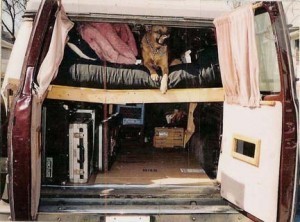
Photo credit: "The Van" by Andrea Jablonski of band Rabid Rabbit
In the previous posts I have described how to prepare yourself to find shows and thus increase your performing experience. Once you get familiar on the stage, and you have acquired enough skills, it may be worth to consider taking your music out to the world. But how can you get to do it?
The process seems indeed quite daunting: organizing shows in a foreign country you barely know, thinking of transportation logistics, backline, time constraints and money matters may give you a headache. Nevertheless, a big number of independent bands are touring every day. It is actually simpler than we think, and it works generally in two ways:
Working with a promoter is definitely the easier way: this person knows everything about that particular country/region's music scene, and can organize a tour for you. He will generally ask you for a presskit and, once he has agreed in booking your band, he will work for you for a fee – generally a 10-15% off every show's guarantee -. Having a promoter or a booking agency behind is a big advantage, which is not always easy to get, tough. Booking agents work mostly with more established bands; therefore, if you only have a demo CD out and struggle for shows, this may not be your first option. Furthermore, by hearing promoters' brutally honest comments, many bands already get discouraged from the reality of the music business and call it quits. Do not do that, as there are other ways to tour independently.
Booking your own tour the whole process is painfully long, will give you headache, insomnia, nausea and will be a huge risk. But once you line up some shows and actually got to play them in a row, you will feel the greatest satisfaction. If you have collected enough contacts of friend bands in different cities, the first step is to try to organize a weekend to 4 or 5 gigs mini tour. Do it over a holiday break as a start. You will have to organize your own transportation, your own backline and probably drive yourself, but you will get to keep all of the money involved. The difficult task here is trying to line up the gigs in a functional itinerary, allowing you to maximize the time on the road, and minimize expenses. This is more easily thought than practically done, as you will have to deal with each and every single promoter's request in every city you decide to hit.
As Booking your own tour deserves more lengthy and detailed explanations, I will write more in-depth suggestions over the next few weeks. For the moment being, please start thinking how to manage your touring options, and start to ask promoters and booking agencies to consider your band. If everything fails, do not worry as I will be providing some ideas in a week time.
Original article can be found here: Vagabonding as a rock musician: a step by step guide. Post #3: international touring
Train trips
Vagablogging :: Rolf Potts Vagabonding Blog
Last week I talked about road trips; but another more eco-friendly way, with a hint of old-fashioned charm, is to travel by train.
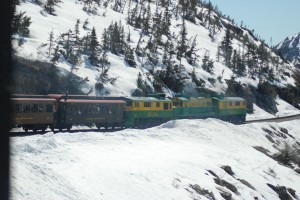
Narrow gauge railroad through "Dead Horse Pass"
The World Train Travel Guide provides a break down, by continent, and has up-to-date news and deals. If you're interested in exploring the U.S.A., the direct site is easy to navigate.
In the Swiss Alps, as I write this, they are digging what eventually will be the longest transportation tunnel in the world–the Gotthard Base Tunnel. But don't go rushing off to Switzerland just yet; it won't be done till 2016.
Some trains are purely scenic; while others provide a commute between countries.
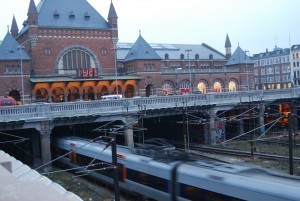
Central station, Copenhagen, Denmark
Perhaps one of the most well-known epic train trips is the Trans-Siberian across Russia. Have you ever been? I flipped on the TV late one night–not long ago–in my hotel and stumbled upon an action thriller movie called, Transsiberian. I'd not recommend watching it before heading off to experience the longest railway in the world. However, it did illustrate both the danger and beauty of railway travel.
The American novelist, Paul Theroux, undertook his first long distance rail journey across Asia. That travelogue became the modern classic, The Great Railway Bazaar. Many years later he decided to retrace his steps and account how both he, and the places, had changed in, Ghost Train to the Eastern Star. Theroux also wrote a third railway adventure book, The Old Patagonian Express, about the Americans.
So now, it might be time I read, The Old Patagonian Express, as I plan my next railway journey in May.
Do you recommend any other train books? Or have train stories to share…
Original article can be found here: Train trips
April 11, 2012
Embracing and settling into new places
Vagablogging :: Rolf Potts Vagabonding Blog
Before I left for my first trip, I often would imagine that moment when I arrived in my first destination, Quetzaltenango, Guatemala. What would I actually do? How, exactly, do I do this traveling thing I've been reading so much about?
I just imagined myself standing there, feeling lost.
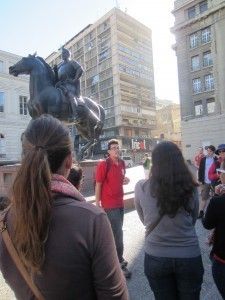
Taking a free or low-cost walking tour can be a great way to get acquainted with a new city.
I'd read this post, Surving your first 24 hours abroad, and planned to keep these suggestions – such as going for a walk, meeting people through Couchsurfing and exercising – in mind.
It turned out I didn't really need these tips at my first destination because I quickly met people and was off exploring, but they have come in handy as I've traveled to about a half dozen more places in the past two months. I've found that sometimes when I arrive somewhere new, I am excited and ready to explore, but other times, I go through an odd transition phase of culture shock and simply not quite liking the place. Plus, I'm often tired from traveling and not in the mood to explore.
I imagine these are common concerns and feelings for first-time travelers like me, so I will share the few additional tactics I've come up with as I learn to embrace and settle into new places:
Go for a walk. This sounds so obvious, but it's true. I don't think there's a better way to get comfortable with a place than to simply walk and look around, sans agenda.
You can also check if there are any free or low-cost walking tours offered. I typically wouldn't recommend such a "touristy" thing, but I actually just went on a free walking tour in Santiago, Chile, and was surprised at how much it inspired me to keep exploring. I gained so many insights from the tour guide – a local – about places to go and things to eat and drink that I never would have found in a guide book. Hearing the historical background on the city's main sites from the perspective of a local also brought them to life and gave me a much deeper appreciation and interest in them. Plus, the tour gave me a general sense of direction in the city so I now can comfortably find my way around.
Talk to a local. Getting the perspectives and tips from a local can't be beat. You can start by talking to the people who work at your hostel – they are typically interested in helping and in sharing their love for their city – or, if you know the language and feel comfortable, simply ask someone you see in the park what they would recommend you do.
Couchsurfing now provides an option to meet locals or other travelers for coffee or exploring, as well. I have not yet done this but plan to in the coming weeks and will report back. Thus far in my travels, I've heard nothing but positive reviews about Couchsurfing. Sounds like the perfect way to get a local perspective on a place.
Sit in the park and people watch. It's amazing how much central parks in foreign countries can tell you about the place. You can often find people playing music, making art, protesting or spreading their beliefs, eating local food or simply playing with their kids. It's a great way to see a variety of aspects of the city all in one place.
Allow yourself to rest. When I first arrived in Santiago after a full day of flying and sitting in airports, I was booked to stay at a busy backpacker hostel. I knew there would be no way I'd be ready to socialize and go out and explore, so I cancelled that reservation and booked at a more quiet hostel – allowing myself a day of rest before getting caught up in traveling.
As a new traveler, it took me several weeks to accept this as part of traveling. We need to rest in order to keep our mind open and ready to explore. After all, an open mind is all you really need to get yourself going in a new place.
Original article can be found here: Embracing and settling into new places
April 10, 2012
See the world, one festival at a time
Vagablogging :: Rolf Potts Vagabonding Blog

Diwali Festival: Photo from BBC
Exploring the world is a treat at any time of year, but a traveler is especially lucky to take part in local celebration. Whether watching la Semana Santa parade from a Valencia balcony or firing super soakers for Thailand's Songkran festival, nothing beats the awe-inspiring experience of participating in local fete. Holidays give the traveler a unique slice of colorful culture and tradition that may be dormant at other times of the year, so keep these celebrations in mind as you book your next trip!
For culture seekers: Looking for a dose of culture in your journey? These events will leave you with an insider perspective on your destination's national pride.
Chinese New Year, China: The Spring Festival in China, known for ridding people of ill fortune and welcoming luck, wealth, longevity, happiness, etc. Each of the festival's 15 days has a purpose, so you've got some studying to do if you want to fully participate.
Day of the Dead, Oaxaca, Mexico: A celebration of the lives of the dead and the continuation of life after death. Expect colorful skeletal costumes and the demystification of crossing over to the other side.
Bastille Day, France: French National Day, or the day to celebrate the start of the French Revolution in 1789. Paris is where the action happens, from military parades to lavish balls and ear-numbing firework displays. Paint your face like the French flag for extra Bastille Day points.
Tet Festival, Vietnam: Tet Nguyen Dan, or "the first morning of the first day of the new year." Like the Chinese, the Vietnamese spend this time cleaning house, getting rid of bad fortune and buying new clothes. Make sure that's really chicken you're eating…it could be dog!
The Summer Redneck Games, Dublin, Georgia: A spoof of the summer Olympics in Georgia that is still going strong. Travelers can experience true redneck culture by bobbing for pigs feet, hub cap hurling or taking part in the mud pit belly-flop contest.
For holy travelers: Spiritual seeks will not be disappointed by the following celebrations around the world. Even the non-religious will feel a spiritual curiosity by simply witnessing these holy practices:
Diwali Festival, India: A five day festival of lights in which candles and lamps are lit to ward off evil spirits. Expect firework noise pollution and lots of spring cleaning! People use this holiday as a time to buy new things and clear out the old.
La Semana Santa (Easter) in Seville, Spain: The Catholic holy week is celebrated extensively in Seville. You'll see over 100 religious floats and hear an entire week of musical processions. Be careful about making too much noise…some of the processions are rather serious.
Holi, India and other Hindu countries: A festival of color to mark the onset of spring and celebrate Hindu mythology. Holi lowers the strictness of many social norms, so count on men and women from different castes, social classes and ages celebrating together with scented colored powder.
St Patrick's Day, Dublin, Ireland: The booze guzzling and rowdy parties may distract us from the true purpose of this day, but St. Patty's celebrates not only the patron saint of Ireland but the entire arrival of Christianity to the country. Think of that the next time you're funneling a green beer!
For food enthusiasts: You'd be surprised how many strange foods are devoured, worshipped, and even thrown around the world each year. Food is at the heart of human society, so it makes sense that cultures devote days and weeks to bizarre fun with their favorite kinds.
La Tomatina , Bunol, Spain: A massive food fight involving 40 metric tons of tomatoes. This isn't entirely a free for all…Tomatoes must be squashed before throwing, the ripping of T-shirts is forbidden and you can't throw tomatoes after the official end of the fight!
Battle of the Oranges, Ivrea, Italy: A battle of oranges that supposedly celebrates a 13th century rebellion in which the poor overthrew a feudal lord tyrant. Beans were originally thrown in this fight, followed by apples and finally, in the 19th century, oranges appeared as a symbol of the duke's chopped off head.
Night of the Radishes, Oaxaca, Mexico: Once a marketing gimmick to encourage radish sales, the Night of Radishes is now a contest of local artisans who win cash prizes for the best radish carvings.
Monkey Buffet Festival, Lopburi, Thailand: An annual buffet for the province's 600 monkeys to honor Rama, a hero who is said to have rewarded the Monkey King with the Lopburi province.
Cheese Rolling, Gloucester, England: A tradition dating back to Roman era, where competitors gather to run up a hill and chase a 7 kg. round cheese back down.
For the party animals: It takes a special kind of partier to survive and thrive in the throws of Germany's Oktoberfest or Brazil's Carnival. We may not all be able to party that hard, but there are fun celebrations around the world for every level of crazy!
Oktoberfest, Munich, Germany: Don't be confused…Oktoberfest actually starts in late September! This Bavarian beer drinking event lasts for 16 days, so be prepared to leave with a few extra pounds.
Rio Carnival, Rio De Janeiro: A colossal festival held before Lent everyday. Over two million people attend this party every year, characterized by outrageous floats, costumes, music and samba dancing.
Full Moon Party, Koh Phangan, Thailand: What originally started as a small beach gathering is now one of the wildest parties in the world. The party begins at dusk and explodes into a massive trance of techno music and dancing that continues into the next day. Watch your drinks at this party, and your wallet!
Burning Man, Nevada, USA: An 8 day pop-up festival in the middle of the desert, this sun-soaked summer party ends with the burning of a 72ft wooden man. Survive by bartering goods for food and supplies, and bring your sunblock.

Photo: designeditor.com
Original article can be found here: See the world, one festival at a time
The 4 P's of Living your Dream
Vagablogging :: Rolf Potts Vagabonding Blog
I was talking with a friend a while ago and he mentioned that the way he had managed to live the life of his dreams was by the 4 P's – prudence, patience, planning, and prioritizing. Ain't that the truth?
No matter what it is that you want to do, you'll do it by following those four basic steps. Take it one step at a time, keep the 4 P's in mind, and you're well on your way to living the life you've dreamed about!
Original article can be found here: The 4 P's of Living your Dream
April 9, 2012
Stay safe when partying abroad
Vagablogging :: Rolf Potts Vagabonding Blog
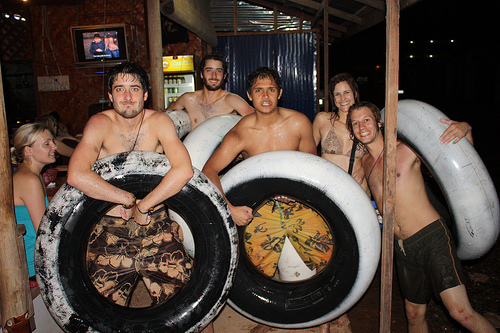
Backpackers tubing in Vang Vieng, Laos. Photo: Nick Hewson / Flickr
When we're away from home, it's tempting to cut loose and forget our inhibitions. A recent piece in The Guardian UK points out the dangers in partying: Vang Vieng, Laos: the world's most unlikely party town.
The article explores how the small Lao town has blown up into a hotspot on the Southeast Asia backpacker trail. While revenues and amenities have increased, safety measures have not. The reporter warns of injuries sustained by backpackers who failed to take the proper care.
"Tubing" is a popular pastime in Vang Vieng. This involves riding down the river in an inflatable tube. Along the river are a strip of bars and pubs to cater to thirsty travelers. A quote from the piece is sobering:
Frequent tragedies occur as a result of mixing alcohol with tubing, and other river stunts. Vang Vieng's tiny hospital recorded 27 tourist deaths in 2011 due to drowning or diving head first into rocks, including that of a 23-year-old Dorset man, Benjamin Light. A senior doctor at the hospital, Dr Chit, says the overall figure is higher because "many fatalities are taken straight to Vientiane".
The Lao government seems hesitant to confront the issue. The writer mentions that many of the bars are owned by powerful interests who have a strong stake in keeping the tourist dollars flowing. Any bad press could put a damper on that. At the same time, backpackers seem unaware of the potential risks in drinking and tubing.
How do you stay safe while partying abroad? Please share your tips and stories in the comments.
Original article can be found here: Stay safe when partying abroad
Travel is an intellectual act as much as a physical one
Vagablogging :: Rolf Potts Vagabonding Blog
"Pilgrims were people who figured things out as they walked. On the road you can think forward, you can think back, you can make a list to remember to tell those at home."
–Anne Carson, "Kinds of Water" (1987)
Original article can be found here: Travel is an intellectual act as much as a physical one
April 7, 2012
Vagabonding Field Reports: Road tripping in Northern California – exploring the underworld at Lava Beds National Monument
Vagablogging :: Rolf Potts Vagabonding Blog
Cost: $50/day
What's the strangest thing you have seen lately?
Lavacicles. These pointy tooth-like projections can be found on the roofs of many of the incredible lava tubes and caves at Lava Beds National Monument in northern California. They formed when viscous lava that was dripping from the top of the tubes cooled and hardened. The tubes themselves were forged when the outer edges of flowing lava from the Medicine Lake Volcano cooled and hardened leaving the inner lava insulated and free flowing. Eventually the lava stopped moving and some of the tubes collapsed in on themselves creating hundreds of caves. This type of cave formation is relatively unique as the vast majority of caves are formed when soluble rock, usually limestone, is eaten away by water over thousands of years.

chocolate lavacicles
Like many caves, there are strange creatures that dwell within, including unusual silver insects, bats and subterranean flesh eating humanoids. Actually the flesh eating humanoids are from the 2005 movie 'The Descent', however when you turn your head lamp off and the darkness engulfs you it's difficult not to think of ghastly horrors. The darkness in a cave is complete and it is bizarre to think how unaccustomed we humans have become to living without light. Once you laugh off the thought of your flesh being gnawed from your bone there is real peace to be found in the darkness.
In addition to lavacicles some of the cave walls glow silver and golden as the light from your head lamp reflects off of water beading from clumps of yellowish bacteria. I'm sure some poor chap thought he had struck gold when he first viewed this phenomenon. The whole experience has got me excited about future spelunking opportunities. Apart from being fascinating it's nice to see the confused and mildly disgusted look someone gives you when you said you went 'spelunking' recently.
Describe a typical day:
Wake in a cheap roadside motel, tent or someone's couch. Head into the inky blackness of some caves to crawl around, bump my helmet head on lavacicles, and marvel at the strangeness of it all. Emerge into a winter wonderland.
On this most recent road trip most of my time was spent spelunking, however above ground there was ample opportunity for wildlife viewing, some spectacular hikes, snowboarding and time to delve into the rich human history of the area. Northern California is a sensational area to explore and one finds it difficult to get bored.
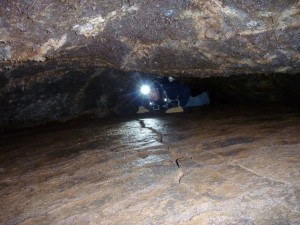
Describe an interesting conversation you had with a local:
Before heading into the caves we met Jesse, a young man who road tripped his way from Tennessee to start a national park internship at lava beds. Despite being paid a meagre $70 a week he is happy to spend the next four months in this beautiful part of the world and hopes to become a US national park ranger. We ended up splelunking all day with him (erm……that sounds weird) and he was kind enough to offer up his couches to crash on so we didn't have to camp in the cold (Bear Grylls would be ashamed of us). He enlightened me on the existence of the sport of ultimate frisbee, which apparently he took quite seriously in college and is a legitimate sport these days. Although I get the feeling placing the word 'ultimate' before any activity makes it sound a lot cooler than it actually is I was intrigued to hear of the level of skill and fitness that the players are required to have. Once I figure out how to throw a frisbee I might seek out a way to partake in a game one day. Until then its ultimate hiking and ultimate spelunking for me.
What do you like about where you are? Dislike?
The remarkable volcanic landscape with views of the incomparable Mount Shasta are hard to beat. It's difficult to find anything to dislike about travelling through this part of the world. Although California is not the cheapest travel destination it is easy to find cheap roadside motels and plenty of great camping spots. I was lucky enough to be traveling with a companion so even with the high price of gas it was a cheap trip. Traveling alone on the other hand could get quite expensive, especially if you have to rent a car and gear. It's obviously quite cold in northern California at certain times of the year, particularly if you are camping, and I had to suppress the urge to whine about my cold fingers from time to time. This, however, is a small price to pay to be surrounded by such beauty.

Emerging from a cave into a snowy wonderland
Describe a challenge you faced:
Apart form the physical challenge of squeezing myself between jagged rocks (Jesse the intern described this as 'like being birthed') it was surprisingly hard at times to figure out our next move due to the lack of internet access and spotty phone reception. I'm almost ashamed at how reliant I have become on the internet when planning my travels. Being without the internet does have its advantages- you are required to chat with locals or fellow travellers and often you stumble upon adventures that you never would have found otherwise.
What new lesson did you learn?
This road trip was more or less a practice run building up to a longer one next month and several months of travel throughout central and South America. I packed my bag as if I was going travelling for several months and discovered that although bundle wrapping clothes sounds like a great idea I will inevitably end up just shoving my clothes in my bag in a random hap hazard way, hoping that they all fit. Therefore I will eliminate some items of clothing in favor of more room so I can just hastily cram all my clothes in my pack. I highly recommend a practice trip, even if its only for a couple of days to work out what you really want to bring before going on a longer trip.
Where next?
To my homeland Australia for three weeks and then back to the USA for another road trip- the Grand Canyon and Utah national parks.
Original article can be found here: Vagabonding Field Reports: Road tripping in Northern California – exploring the underworld at Lava Beds National Monument
Rolf Potts's Blog
- Rolf Potts's profile
- 323 followers




